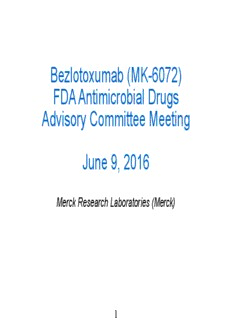
Merck Presentations for the June 9, 2016 Meeting of the Antimicrobial Drugs Advisory Committee PDF
Preview Merck Presentations for the June 9, 2016 Meeting of the Antimicrobial Drugs Advisory Committee
Bezlotoxumab (MK-6072) FDA Antimicrobial Drugs Advisory Committee Meeting June 9, 2016 Merck Research Laboratories (Merck) 1 Agenda Bezlotoxumab Introduction Donnette Staas, PhD Director, Regulatory Affairs Merck Clinical Program: Overview and Dalya Guris, MD, MPH Efficacy Executive Director, Clinical Research Merck Clinical Program: Safety Yoshihiko Murata, MD, PhD Director, Clinical Research Merck Benefit/Risk and Conclusions Mark H. Wilcox, MD, FRCPath Professor of Medical Microbiology Leeds Teaching Hospitals & University of Leeds Lead on C. difficile, Public Health England 2 C. difficile Infection: An Urgent Public Health Threat C. difficile: Spore-forming organism ubiquitous in hospital environment – C. difficile infection (CDI) has become the leading cause of hospital- acquired infection – Incidence of community-acquired CDI is also increasing Estimated 453,000 incident CDI episodes in the US in 20111 – 83,000 first recurrences of CDI – 29,000 CDI-associated deaths (greater than MRSA and MDR Gram- negative infections combined) CDC declared C. difficile 1 of 3 urgent antibiotic resistance threats 1 Lessa, et al. NEJM. 2015. MDR=multidrug-resistant; MRSA=methicillin-resistant Staphylococcus aureus. 3 C. difficile Infection Recurrence1 70% s e d ~60% o 60% s i p E 50% I D C ~40% t n 40% e r r u c 30% e R of 20-35% 20% e g a t n 10% e c r e P 0% After first episode After first recurrence After 2+ recurrences 1 McFarland, et al. Am J Gastro. 2002. 4 CDI: Current Therapy Standard of care (SoC) treatment of CDI includes: – Oral/IV metronidazole – Oral vancomycin – Oral fidaxomicin Antibiotic treatment of CDI does not prevent recurrent disease – Antibiotic treatment with metronidazole or vancomycin disrupts normal gut microbiota, which facilitates development of CDI recurrence – CDI recurs at a substantial rate after fidaxomicin as well, in particular in those infected with the ribotype 027 (NAP1/BI) There are no approved therapies for the prevention of CDI recurrence 5 CDI Pathogenesis1 Antibiotic treatment Disruption of normal enteric flora Expression of C. difficile Acquisition of toxigenic Toxins A and B Patient Clostridium difficile 1 Poutanen, et al. JAMC. 2004. 6 CDI Pathogenesis1 Antibiotic treatment Disruption of normal enteric flora Expression of C. difficile Acquisition of toxigenic Toxins A and B Patient Clostridium difficile C. difficile Infection Symptoms range from mild diarrhea, to profuse diarrhea with abdominal pain, to toxic Asymptomatic megacolon requiring colectomy, and C. difficile sometimes death colonization (carrier state) Low likelihood of C. difficile infection May act as reservoir for spread of C. difficile 1 Poutanen, et al. JAMC. 2004. 7 CDI Pathogenesis1 Antibiotic treatment Disruption of normal enteric flora Expression of C. difficile Acquisition of toxigenic Toxins A and B Patient Clostridium difficile C. difficile Infection Symptoms range from mild diarrhea, to profuse diarrhea with abdominal pain, to toxic Asymptomatic megacolon requiring colectomy, and C. difficile sometimes death colonization (carrier state) SoC therapy: Metronidazole Treatment 65-80% 20-35% Vancomycin Fidaxomicin Low likelihood of C. difficile No recurrent C. difficile Recurrent C. difficile infection infection infection after treatment after treatment May act as reservoir for spread of C. difficile 1 Poutanen, et al. JAMC. 2004. 8 CDI Pathogenesis1 Antibiotic treatment Disruption of normal enteric flora Expression of C. difficile Acquisition of toxigenic Toxins A and B Patient Clostridium difficile Circulating antitoxin antibodies are protective against primary and recurrent CDI2 Asymptomatic C. difficile colonization (carrier state) Treatment 65-80% 20-35% Low likelihood of C. difficile No recurrent C. difficile Recurrent C. difficile infection infection infection after treatment after treatment May act as reservoir for spread of 1 Poutanen, et al. JAMC. 2004. C. difficile 2 Kyne, et al. Lancet. 2001; Leav, et al. Vaccine. 2010. 9 Introduction: Bezlotoxumab Novel approach to the prevention of CDI recurrence Immune responses against toxins A/B are correlated with reduced recurrence of CDI1 Bezlotoxumab (BEZLO, MK-6072): – Fully human IgG1 monoclonal antibody (mAb) that neutralizes C. difficile toxin B – Directed to the C-terminus ligand binding region of toxin B – Evaluated alone and in combination† with actoxumab (ACTO, MK-3415) • ACTO: fully human mAb targeting toxin A 1Kyne, et al. Lancet. 2001; Leav, et al. Vaccine. 2010. † ACTO+BEZLO (MK-3415A): combined administration of ACTO and BEZLO. 10
Description: